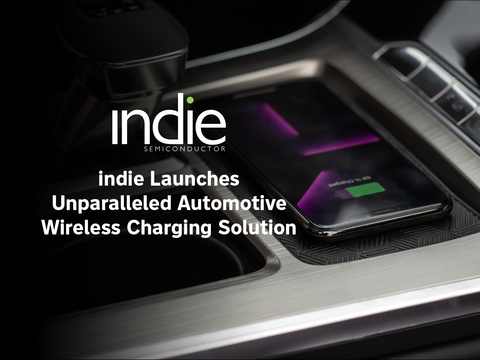indie Semiconductor Launches Unparalleled Automotive Wireless Charging Solution
- Enables in-cabin device charging compliant with Wireless Power Consortium (WPC) Qi 1.3 standard
- Supports emerging Qi 2.0 standard for improved ‘on-the-move’ charging reliability
- Significant external component reduction, reducing implementation complexity, footprint and cost
- Fully qualified to AEC-Q100 Grade 2

indie Launches Unparalleled Automotive Wireless Charging Solution (Graphic: Business Wire)
In-cabin charging has become a necessity for drivers and passengers who use their smartphone to provide navigation, music, voice connections and other services on-the-move. The global semiconductor-enabled in-car automotive wireless charger market is estimated1 at
“indie’s breakthrough automotive wireless charging solution speeds device charging times and delivers industry-leading levels of semiconductor and software integration, reducing the external bill-of-materials by almost half relative to existing discrete implementations,” said Fred Jarrar, vice president and general manager of indie Semiconductor's Power and USB product lines. “This turn-key architecture dramatically reduces system complexity, improves overall reliability and de-risks tier 1 time to market. As a result, indie’s latest SoC will play a pivotal role in enabling automotive OEMs to deliver faster, cost-effective and more reliable portable device charging, contributing to an engaging in-cabin user experience spanning feature-rich cars to entry-level vehicles.”
The iND87200 dual-core design combines an Arm® Cortex® M4F processor with 2MB of embedded Flash and 256kB of SRAM with a dedicated Arm Cortex M0 processor for the WPC stack. This approach frees SoC compute resources to execute user-specific software without timing and interrupt constraints related to the WPC stack. Further, indie’s wireless charging solution integrates all of the necessary power management, DC-DC converter, signal conditioning, WPC inverter drivers, and power FETs as well as LED and fan drivers. A wide range of serial interfaces such as CAN 2.0B, LIN, I2C, and UARTs provide multiple connectivity options to the vehicle and other peripherals.
Fully qualified to AEC-Q100 Grade 2, the iND87200 is production released and sampling to customers. In addition to the SoC, indie is also offering advanced application-oriented reference designs to further accelerate the customer development and deployment process.
About indie
indie is empowering the Autotech revolution with next generation automotive semiconductors and software platforms. We focus on developing innovative, high-performance and energy-efficient technology for ADAS, user experience and electrification applications. Our mixed-signal SoCs enable edge sensors spanning Radar, LiDAR, Ultrasound, and Computer Vision, while our embedded system control, power management and interfacing solutions transform the in-cabin experience and accelerate increasingly automated and electrified vehicles. We are an approved vendor to Tier 1 partners and our solutions can be found in marquee automotive OEMs worldwide. Headquartered in
Safe Harbor Statement
This communication contains “forward-looking statements” (including within the meaning of Section 21E of the United States Securities Exchange Act of 1934, as amended, and Section 27A of the Securities Act of 1933, as amended) concerning indie Semiconductor such as the features, functionality, performance, availability, timing and expected benefits of indie Semiconductor products and technology, including its wireless charging products. Such statements include, but are not limited to, statements regarding our future business and financial performance and prospects, and other statements identified by words such as “will likely result,” “expect,” “anticipate,” “estimate,” “believe,” “intend,” “plan,” “project,” “outlook,” “should,” “could,” “may” or words of similar meaning. Such forward-looking statements are based upon the current beliefs and expectations of our management and are inherently subject to significant business, economic and competitive uncertainties and contingencies, many of which are difficult to predict and generally beyond our control. Actual results and the timing of events may differ materially from the results included in such forward-looking statements. In addition to the factors previously disclosed in our Annual Report on Form 10-K for the fiscal year ended December 31, 2022 filed with the SEC on March 28, 2023 and in our other public reports filed with the SEC (including those identified under “Risk Factors” therein), the following factors, among others, could cause actual results and the timing of events to differ materially from the anticipated results or other expectations expressed in the forward-looking statements: the impact of the COVID-19 pandemic; the impact of Russia’s invasion of
Investors are cautioned not to place undue reliance on the forward-looking statements in this press release, which information set forth herein speaks only as of the date hereof. We do not undertake, and we expressly disclaim, any intention or obligation to update any forward-looking statements made in this announcement or in our other public filings, whether as a result of new information, future events or otherwise, except as required by law.
View source version on businesswire.com: https://www.businesswire.com/news/home/20230629514830/en/
Investor Relations
ir@indiesemi.com
Source: indie Semiconductor







